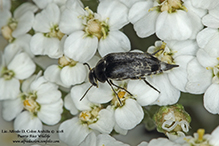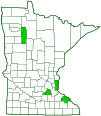blistered tumbling flower beetle
(Mordellina pustulata)
Conservation • Description • Habitat • Ecology • Distribution • Taxonomy
Conservation Status |
|
|||||||
| IUCN Red List | not listed |
|||||||
| NatureServe | NNR - Unranked |
|||||||
| Minnesota | not listed |
|||||||
Description |
||
Blistered tumbling flower beetle is a small tumbling flower beetle. It occurs in southern Canada and in northwestern and eastern North America. The body is 1 ⁄16″ to ⅛″ (2 to 4 mm) long, more or less wedge-shaped, and broadest in front when viewed from above. When viewed from the side it is convex overall and strongly arched in front, making it appear humpbacked. The head is black, short, and bent downward. It is attached toward the bottom to the body. There are two large compound eyes and no simple eyes (ocelli). The mouthparts are directed downward. The antennae have 11 segments. On the male the antennae are long and thread-like. On the female they are shorter and somewhat sawtoothed (sub-serrate). They are black except for the first three or four segments, which are reddish-brown. The exoskeletal plate covering the thorax (pronotum) is black, a little wider than long, and narrowed toward the head. It is as wide at the base as the base of the hardened wing covers (elytra). The abdomen is long and narrow. The last abdominal is extended into a long, slender, pointed style at the end and is not completely covered by the elytra. The elytra are black with numerous, small, silvery spots that sometimes coalesce into narrow broken bands. The head is minutely punctured (pitted), the pronotum finely punctured, and the elytra coarsely punctured. The front legs are pale reddish-brown. The rear legs are longer and stouter than the front and middle legs. On the front and middle legs the last part of the leg (tarsus), corresponding to the foot, has 5 segments. On the hind legs the tarsus has only 4 segments. |
||
Size |
||
Body Length (not including anal style): 1 ⁄16″ to ⅛″ (2 to 4 mm) Total length: ⅛″ to ¼″ (2.5 to 5.5 mm) |
||
Similar Species |
||
Habitat |
||
|
||
Ecology |
||
Season |
||
February to September |
||
Behavior |
||
When threatened, the beetle will kick its hind legs rapidly and repeatedly, causing it to bounce or tumble unpredictably. |
||
Life Cycle |
||
|
||
Larva Food |
||
|
||
Adult Food |
||
|
||
Distribution |
||||
|
Sources |
|||
| 2/4/2023 | ||||
Occurrence |
||||
|
||||
Taxonomy |
|||
Order |
Coleoptera (Beetles) | ||
Suborder |
Polyphaga (Water, Rove, Scarab, Long-horned, Leaf, and Snout Beetles) | ||
Infraorder |
Cucujiformia | ||
Superfamily |
Tenebrionoidea (darkling beetles and allies) | ||
Family |
Mordellidae (tumbling flower beetles) | ||
Subfamily |
Mordellinae | ||
Tribe |
Mordellistenini | ||
Genus |
Mordellina | ||
Synonyms |
|||
Mordellistena pustulata |
|||
Common Names |
|||
blistered tumbling flower beetle |
|||
Glossary
Elytra
The hardened or leathery forewings of beetles used to protect the fragile hindwings, which are used for flying. Singular: elytron.
Ocellus
Simple eye; an eye with a single lens. Plural: ocelli.
Pronotum
The exoskeletal plate on the upper side of the first segment of the thorax of an insect.
Tarsus
On insects, the last two to five subdivisions of the leg, attached to the tibia; the foot. On spiders, the last segment of the leg. Plural: tarsi.
visitor Photos |
|||||
Share your photo of this insect. |
|||||
| This button not working for you? Simply email us at info@MinnesotaSeasons.com. Attach one or more photos and, if you like, a caption. |
|||||
Alfredo Colon |
|||||
 |
|||||
MinnesotaSeasons.com Photos |
|||||
|
|||||

Slideshows |
||

visitor videos |
|||
Share your video of this insect. |
|||
| This button not working for you? Simply email us at info@MinnesotaSeasons.com. Attach a video, a YouTube link, or a cloud storage link. |
|||
Other videos |
|||

Created: 7/5/2019
Last Updated:


